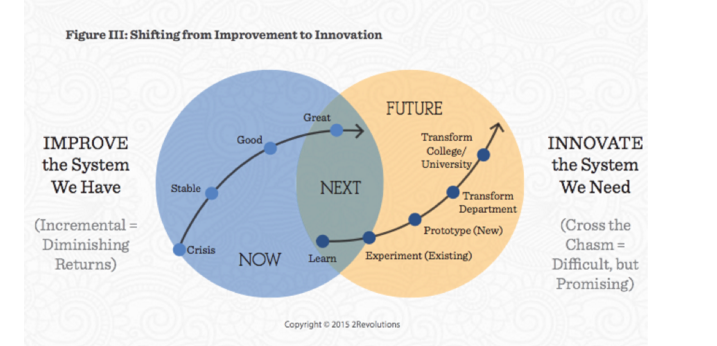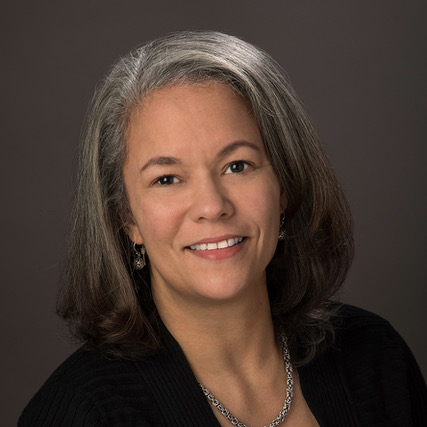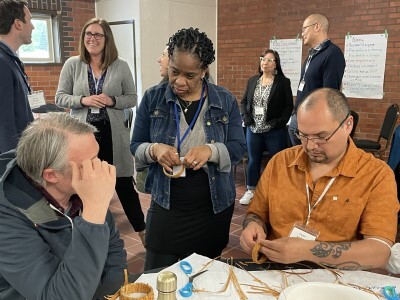Down the Rabbit Hole? 3 Key Takeaways for Higher Ed Business Models
Topics

Next generation learning is all about everyone in the system—from students through teachers to policymakers—taking charge of their own learning, development, and work. That doesn’t happen by forcing change through mandates and compliance. It happens by creating the environment and the equity of opportunity for everyone in the system to do their best possible work.
To build successful higher ed business models, leaders should focus on these three takeaways.
Steve Jobs referred to them as ‘the crazy ones’—those who aren’t fond of rules, and have no respect for the status-quo. I get what he was talking about. In my work at EDUCAUSE, I’ve been fortunate to meet some of these fascinating people: those who are innovating (or making some very bold plans to do so) within the hallowed halls of higher ed still ripe for disruption. They are current faculty and former administrative leaders; they are funding officers, philanthropists or folks from competitive start-up scenes; they are fiercely passionate alumni and business professionals who just know there’s got to be a better way.
Recently, I was among a handful of such people: friends and acquaintances who get pretty darn excited talking about the future of the higher ed business model. (While it may be a bit frightening to consider what this says about us, in our defense, we had a lively celebration the prior evening in honor of rpkGROUP’s fifth anniversary and I assure you that was a fine time indeed!)
Conversations about higher ed finance usually go down one of two pathways: one path is filled with ominous numbers, percentages and other foreboding quantitative elements, while the second path is filled with ambiguous, sometimes disconnected conversations about budget cuts and quality implications. (The latter inevitably leads to questions about defining quality, and whether this overlaps with relevance.)
The end game isn’t pretty. Both paths can land you into an experience akin to something like the crazy labyrinth that Harry Potter and friends went through in Harry Potter and the Goblet of Fire.
Unlike Harry and friends, however, we managed to avoid an unpleasant end with the help of apt facilitation and some very smart guiding questions from Bryan Setser, Chief Design Officer at Matchbook Learning, and Rick Staisloff, Principal of the rpkGROUP. Here are the three case studies we reviewed:
- Davis & Elkins College, a traditional college that drastically improved its profile through the focused work of a charismatic leader;
- College for America, an off-shoot of Southern New Hampshire University, a traditional university that iterated on an existing concept (competency-based education) and by infusing modern technology, created a revolutionary new approach to delivering higher education; and
- General Assembly, a skills provider with a laser-sharp focus on labor market needs and an astonishing placement rate for participants.
What are the takeaways for higher ed? Here are the key points that emerged from our discussion:
Future Higher Ed Business Models Have to Include Improvement Goals AND Innovation Goals
Most of today’s higher ed leaders have their hands full just trying to make enough creative-yet-legal moves within their existing budgets that ensure on-time arrivals and departures of the current trains—including both academic and administrative services. The idea of committing time, talent and capital toward innovation is daunting at best, and utterly discouraging at worst. And while there are innovators in our field doing just that, suffice it to say that it’s not an easy lift for anyone within higher ed to both improve and innovate at the same time.
What qualities did the case studies that we read have in common? Each had an element of scanning the horizon and preparing for the future, even as the main work of the enterprise moved ahead. It looked a little different in each context, but all were future-focused in some way:
- For Davis & Elkins, looking ahead is about succession planning and finding leadership ready to continue when their beloved president takes the retirement long due to him.
- For College for America, looking ahead is a multi-front challenge: enrolling new employers, reaching new students and pushing better technology solutions.
- For General Assembly, looking ahead is about monitoring the market and staying 100% relevant, which is no small feat in the era of lightning speed tech change and 24-hour news cycles.
Here’s how that plays out graphically:

Institutional Goals Have to Align with Stakeholders’ Goals
In addition to having a strong orientation toward the future, all three case studies along this continuum of improvement and innovation shared another focus: stakeholders’ goals. Whether this involved boards of directors, students, or employers, all three underscored the critical importance of alignment to important stakeholder needs.
This wasn’t surprising to me. After watching higher ed leaders grapple with issues facing the field in EDUCAUSE’s Breakthrough Models Incubator and the Breakthrough Models Academy, it’s very clear that no one is going to move forward alone. Partnerships with philanthropy, the private sector, even competitors, in some instances, are going to be required to articulate a future vision and a sustainable business model(s).
Business Models Are About Much More than Money
Moving forward does require money—to prototype and explore possible solutions, to pilot ideas and iterate toward scale, to hire new people to do new things. Not only do we need money to invest, we need to make money in the end.
And just where is that money going to come from, anyway?
Academy and Incubator participants already know the answer to this, courtesy of rpkGROUP and Rick Staisloff. It will take a mindset shift from budgeting to investing.
It will mean a departure from traditional thinking about ‘how much are we allowed to spend on X?’ to instead considering ‘what return will we see if we invest in X?’ It will take the courage to act on the information we get from our analysis of the returns. As avant-garde as it might be to offer Underwater Basket-Weaving as a major, if it’s not core to the mission and doesn’t return resources to the goal of fulfilling the mission, we have to be prepared to pivot toward drivers that align BOTH mission and margin. As my friends and I pondered the alignment of margin and mission, additional questions arose:
- Will this line of thinking eclipse equity issues? (We didn’t think so, but innovators need to be explicit in articulating equity issues and addressing them.)
- What is the real value of higher education, anyway? (That answer’s too long—next post.)
- Which markets do we serve and/or need to serve? (Clearly there is a shift toward serving working adults, but serving markets has broader implications for society as a whole. Another long discussion; another post—wait this is becoming a series...)
If you care about the business model for higher ed, join the conversation. Ping me with your interest about it and I’ll let you know the next (physical or virtual) location for our “Friends of Higher Ed Finance Meetup.” BYOB and the latest copy of Harvard Business Review, and we’ll have some serious fun with finance.




